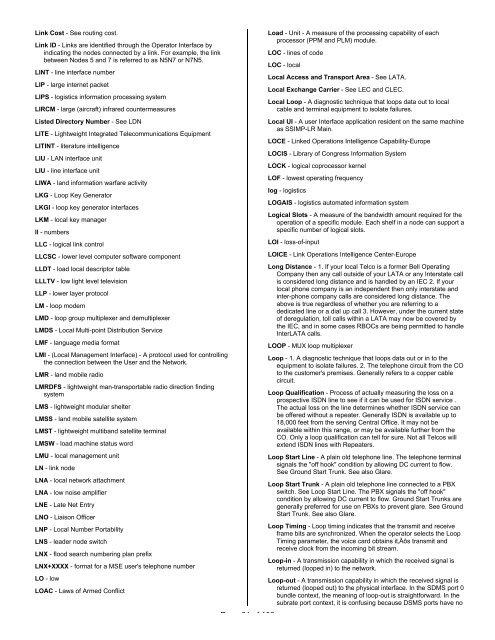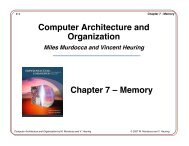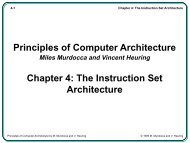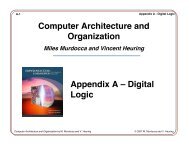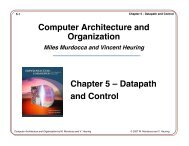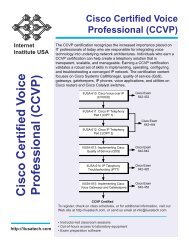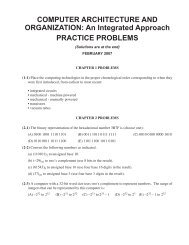Glossary, Acronyms, and Abbreviations - IIUSA
Glossary, Acronyms, and Abbreviations - IIUSA
Glossary, Acronyms, and Abbreviations - IIUSA
Create successful ePaper yourself
Turn your PDF publications into a flip-book with our unique Google optimized e-Paper software.
Link Cost - See routing cost.<br />
Link ID - Links are identified through the Operator Interface by<br />
indicating the nodes connected by a link. For example, the link<br />
between Nodes 5 <strong>and</strong> 7 is referred to as N5N7 or N7N5.<br />
LINT - line interface number<br />
LIP - large internet packet<br />
LIPS - logistics information processing system<br />
LIRCM - large (aircraft) infrared countermeasures<br />
Listed Directory Number - See LDN<br />
LITE - Lightweight Integrated Telecommunications Equipment<br />
LITINT - literature intelligence<br />
LIU - LAN interface unit<br />
LIU - line interface unit<br />
LIWA - l<strong>and</strong> information warfare activity<br />
LKG - Loop Key Generator<br />
LKGI - loop key generator interfaces<br />
LKM - local key manager<br />
ll - numbers<br />
LLC - logical link control<br />
LLCSC - lower level computer software component<br />
LLDT - load local descriptor table<br />
LLLTV - low light level television<br />
LLP - lower layer protocol<br />
LM - loop modem<br />
LMD - loop group multiplexer <strong>and</strong> demultiplexer<br />
LMDS - Local Multi-point Distribution Service<br />
LMF - language media format<br />
LMI - (Local Management Interface) - A protocol used for controlling<br />
the connection between the User <strong>and</strong> the Network.<br />
LMR - l<strong>and</strong> mobile radio<br />
LMRDFS - lightweight man-transportable radio direction finding<br />
system<br />
LMS - lightweight modular shelter<br />
LMSS - l<strong>and</strong> mobile satellite system<br />
LMST - lightweight multib<strong>and</strong> satellite terminal<br />
LMSW - load machine status word<br />
LMU - local management unit<br />
LN - link node<br />
LNA - local network attachment<br />
LNA - low noise amplifier<br />
LNE - Late Net Entry<br />
LNO - Liaison Officer<br />
LNP - Local Number Portability<br />
LNS - leader node switch<br />
LNX - flood search numbering plan prefix<br />
LNX+XXXX - format for a MSE user's telephone number<br />
LO - low<br />
LOAC - Laws of Armed Conflict<br />
Page 61 of 106<br />
Load - Unit - A measure of the processing capability of each<br />
processor (PPM <strong>and</strong> PLM) module.<br />
LOC - lines of code<br />
LOC - local<br />
Local Access <strong>and</strong> Transport Area - See LATA.<br />
Local Exchange Carrier - See LEC <strong>and</strong> CLEC.<br />
Local Loop - A diagnostic technique that loops data out to local<br />
cable <strong>and</strong> terminal equipment to isolate failures.<br />
Local UI - A user Interface application resident on the same machine<br />
as SSIMP-LR Main.<br />
LOCE - Linked Operations Intelligence Capability-Europe<br />
LOCIS - Library of Congress Information System<br />
LOCK - logical coprocessor kernel<br />
LOF - lowest operating frequency<br />
log - logistics<br />
LOGAIS - logistics automated information system<br />
Logical Slots - A measure of the b<strong>and</strong>width amount required for the<br />
operation of a specific module. Each shelf in a node can support a<br />
specific number of logical slots.<br />
LOI - loss-of-input<br />
LOICE - Link Operations Intelligence Center-Europe<br />
Long Distance - 1. If your local Telco is a former Bell Operating<br />
Company then any call outside of your LATA or any Interstate call<br />
is considered long distance <strong>and</strong> is h<strong>and</strong>led by an IEC 2. If your<br />
local phone company is an independent then only interstate <strong>and</strong><br />
inter-phone company calls are considered long distance. The<br />
above is true regardless of whether you are referring to a<br />
dedicated line or a dial up call 3. However, under the current state<br />
of deregulation, toll calls within a LATA may now be covered by<br />
the IEC, <strong>and</strong> in some cases RBOCs are being permitted to h<strong>and</strong>le<br />
InterLATA calls.<br />
LOOP - MUX loop multiplexer<br />
Loop - 1. A diagnostic technique that loops data out or in to the<br />
equipment to isolate failures. 2. The telephone circuit from the CO<br />
to the customer's premises. Generally refers to a copper cable<br />
circuit.<br />
Loop Qualification - Process of actually measuring the loss on a<br />
prospective ISDN line to see if it can be used for ISDN service .<br />
The actual loss on the line determines whether ISDN service can<br />
be offered without a repeater. Generally ISDN is available up to<br />
18,000 feet from the serving Central Office. It may not be<br />
available within this range, or may be available further from the<br />
CO. Only a loop qualification can tell for sure. Not all Telcos will<br />
extend ISDN lines with Repeaters.<br />
Loop Start Line - A plain old telephone line. The telephone terminal<br />
signals the "off hook" condition by allowing DC current to flow.<br />
See Ground Start Trunk. See also Glare.<br />
Loop Start Trunk - A plain old telephone line connected to a PBX<br />
switch. See Loop Start Line. The PBX signals the "off hook"<br />
condition by allowing DC current to flow. Ground Start Trunks are<br />
generally preferred for use on PBXs to prevent glare. See Ground<br />
Start Trunk. See also Glare.<br />
Loop Timing - Loop timing indicates that the transmit <strong>and</strong> receive<br />
frame bits are synchronized. When the operator selects the Loop<br />
Timing parameter, the voice card obtains it’s transmit <strong>and</strong><br />
receive clock from the incoming bit stream.<br />
Loop-in - A transmission capability in which the received signal is<br />
returned (looped in) to the network.<br />
Loop-out - A transmission capability in which the received signal is<br />
returned (looped out) to the physical interface. In the SDMS port 0<br />
bundle context, the meaning of loop-out is straightforward. In the<br />
subrate port context, it is confusing because DSMS ports have no


